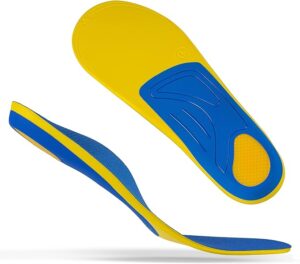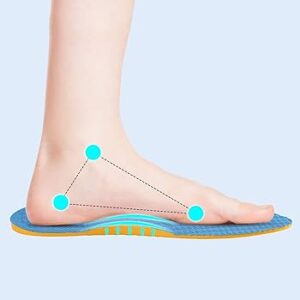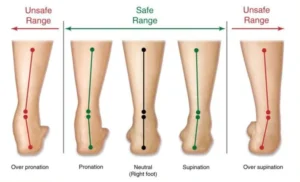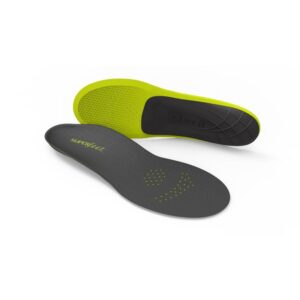
Arch Support
When it comes to enjoying the great outdoors, whether it’s hiking through rugged trails, embarking on a camping trip, or simply exploring nature, having the right footwear is essential. One crucial factor that often goes overlooked is arch support. In this comprehensive guide, we’ll delve into the importance of arch support for hiking and outdoor adventures, and how it can make a world of difference in your outdoor experiences.
Understanding the Arch: Your Foot’s Natural Support
Before we delve into the world of arch support, it’s important to understand what the arch of your foot is. The arch is the curved structure on the bottom of your foot, consisting of bones, tendons, and ligaments. It acts as a natural shock absorber and plays a crucial role in supporting your body weight.
Why Arch Support Matters in Hiking
- Enhanced Comfort: Hiking often involves traversing uneven terrain, which can exert stress on your feet. Proper arch support helps distribute your body weight more evenly across your feet, reducing discomfort and fatigue.
- Stability and Balance: Uneven trails and rocky paths can challenge your balance. Arch support provides stability by aligning your feet correctly, reducing the risk of twisting an ankle or slipping on uneven surfaces.
- Shock Absorption: Hiking can subject your feet to repeated impacts, especially when descending steep slopes. Arch support helps absorb shock and cushion your feet, preventing pain and minimizing the risk of injuries.
- Prevention of Overpronation: Overpronation, where your foot rolls excessively inward, can strain your arches and lead to discomfort or injuries. Arch support helps correct this motion, promoting a more natural gait.
- Reduced Risk of Blisters and Sores: Arch support can prevent your feet from rubbing against the sides of your shoes, reducing friction and the likelihood of blisters or sores.
- Protection Against Plantar Fasciitis: Plantar fasciitis, a common hiking injury, occurs when the tissue along the bottom of your foot becomes inflamed. Arch support can alleviate strain on the plantar fascia, reducing the risk of this painful condition.
- Longer Hiking Duration: With proper arch support, you’ll be able to hike for longer durations without experiencing as much discomfort or fatigue. This allows you to enjoy extended outdoor adventures without discomfort holding you back.

In summary, arch support in hiking is essential for comfort, stability, injury prevention, and overall enjoyment of outdoor adventures. Investing in quality footwear or insoles with adequate arch support can make a significant difference in your hiking
Types of Arch Support
- Insoles:
- Description: Arch support insoles are perhaps the most popular choice among hikers. They are designed to be placed inside your hiking boots or shoes to provide additional cushioning and support for your arches.
- Benefits: Insoles are versatile and come in various shapes and sizes, catering to different foot arch types. They are removable and can be transferred between different pairs of footwear, making them a cost-effective choice.
- Boots and Shoes with Arch Support:
- Description: Some hiking boots and shoes are specifically designed with built-in arch support. These footwear options feature arch contours and cushioning to offer support to your feet while you’re on the trail.
- Benefits: Choosing hiking boots or shoes with built-in arch support eliminates the need for additional insoles. It’s a convenient option for those who prefer an all-in-one solution.
- Custom Orthotics:
- Description: For individuals with specific foot conditions or highly customized arch support needs, custom orthotics may be recommended. These are specially designed inserts made based on the individual’s foot shape and arch requirements.
- Benefits: Custom orthotics provide the highest level of personalized support, ensuring a perfect fit and addressing specific foot issues. They are prescribed by podiatrists or orthopedic specialists.
- Over-the-Counter Arch Support Inserts:
- Description: Over-the-counter (OTC) arch support inserts are readily available in most stores. They offer a middle-ground solution between custom orthotics and standard insoles, providing some degree of customization.
- Benefits: OTC arch support inserts are affordable and accessible, making them a good choice for those looking for better arch support without a customized fit.
- Compression Socks and Sleeves:
- Description: Compression socks and sleeves provide mild compression to the arch area. While not as robust as insoles or custom orthotics, they can offer some support and help improve circulation.
- Benefits: These accessories are lightweight, easy to wear, and can be used in combination with other arch support options to enhance overall comfort.
- Strapping and Taping:
- Description: In some cases, strapping or taping the foot may be recommended by healthcare professionals to provide temporary arch support. This method can help alleviate pain and discomfort during hikes.
- Benefits: Strapping or taping is a low-cost, temporary solution that can be useful when immediate arch support is needed.
- Stretching and Strengthening Exercises:
- Description: While not a physical arch support product, exercises that stretch and strengthen the muscles in your feet and calves can help improve arch support naturally.
- Benefits: These exercises can be incorporated into your routine to enhance your arches’ strength and flexibility over time, reducing the need for extensive external support.
The choice of arch support method should depend on your individual needs, the type of terrain you’ll be hiking on, and any pre-existing foot conditions. It’s advisable to consult with a healthcare professional or a podiatrist to determine the most suitable arch support option for your unique requirements.
Choosing the Right Footwear
When it comes to choosing the right footwear with excellent arch support for your outdoor adventures, you might consider exploring options that offer “Atlas Arch Support.” The Atlas Arch Support system is known for its ability to provide exceptional comfort and stability for your feet. Here’s how to find and evaluate footwear with Atlas Arch Support:
- Research Brands: Start by researching footwear brands known for incorporating Atlas Arch Support technology into their products. Some well-established brands prioritize this feature to enhance the overall hiking experience.
- Product Descriptions: Look for product descriptions or labels that specifically mention “Atlas Arch Support.” This indicates that the footwear has been designed with this advanced arch support system.
- Visit Retailers: Visit physical stores or online retailers that offer a wide range of hiking boots and shoes. These retailers often provide detailed product descriptions and customer reviews, which can help you identify options with Atlas Arch Support.
- Consult Expert Advice: If you’re uncertain about which brands or models feature Atlas Arch Support, consult with store staff or online customer service representatives. They can guide you to suitable options based on your preferences and needs.
- Read Customer Reviews: Customer reviews can provide valuable insights into the effectiveness of Atlas Arch Support in specific footwear. Look for reviews from hikers who have used these products in various outdoor conditions.
- Try Them On: If possible, try on the footwear in-store to assess the comfort and fit. Pay attention to how the Atlas Arch Support feels against your own arch type. It should provide a noticeable level of cushioning and support.
- Consider Your Activity: Think about the type of outdoor activities you’ll be engaging in. Whether it’s hiking, trekking, or other adventures, ensure that the footwear with Atlas Arch Support aligns with the demands of your chosen activity.
- Check for Customization: Some footwear with Atlas Arch Support may offer customization options. Check if you can adjust the level of arch support to suit your specific needs.
- Budget: Determine your budget for hiking footwear. Atlas Arch Support technology can be found in a range of price points, so you can likely find an option that fits within your budget.
- Warranty and Return Policies: Review the manufacturer’s warranty and the retailer’s return policy. This ensures that you have the option to exchange or return the footwear if it doesn’t meet your expectations.
- Fit and Comfort: Prioritize the fit and overall comfort of the footwear. Arch support is essential, but the shoes or boots should also be comfortable to wear for extended periods during your outdoor adventures.
- Consider Accessories: In addition to footwear, consider complementary accessories like moisture-wicking socks and properly fitted insoles with Atlas Arch Support to maximize comfort and support.
By following these steps and considering the Atlas Arch Support feature in your footwear selection, you can enhance your outdoor experiences by ensuring optimal arch support, comfort, and stability throughout your adventures.
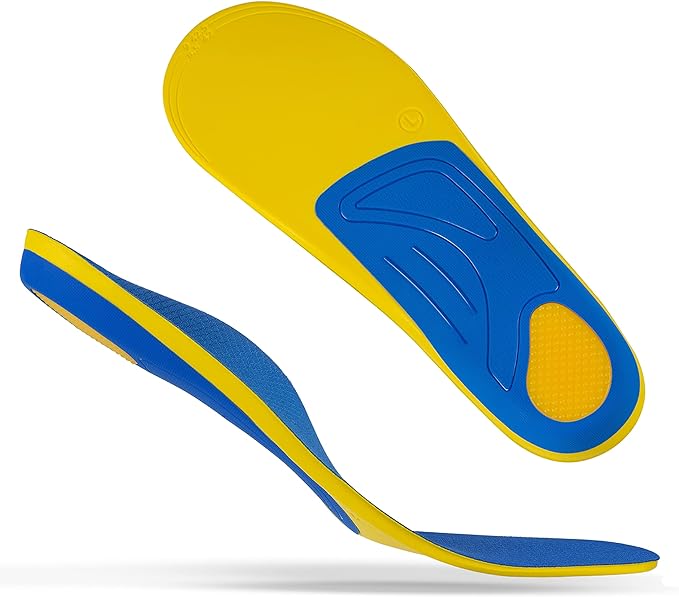
Benefits of Proper Arch Support
Proper arch support offers a wide range of benefits, especially during hiking and outdoor adventures. Here are some of the key advantages:
- Enhanced Comfort: Arch support helps distribute your body weight evenly across your feet, reducing pressure points and discomfort. This leads to a more comfortable hiking experience, allowing you to enjoy the outdoors without the distraction of foot pain.
- Improved Stability: Proper arch support aligns your feet correctly, enhancing stability and balance. This is crucial when navigating uneven terrain, rocky paths, or steep slopes, as it reduces the risk of ankle twists or falls.
- Shock Absorption: Hiking often involves repetitive impacts on your feet, especially when descending. Arch support acts as a shock absorber, reducing the stress on your feet and lower limbs. This minimizes the risk of fatigue and injuries.
- Prevention of Overpronation: Overpronation, where the foot rolls excessively inward, can lead to discomfort and injuries. Arch support helps correct this motion, promoting a more natural and efficient gait.
- Reduced Fatigue: Long hikes can be physically demanding, and without proper arch support, your feet may become fatigued quickly. Arch support minimizes strain, allowing you to hike for longer durations with less fatigue.
- Minimized Risk of Blisters and Sores: Arch support helps maintain proper foot alignment within your footwear, reducing friction and the likelihood of blisters, hot spots, or sores. This is particularly important for extended outdoor activities.
- Prevention of Plantar Fasciitis: Plantar fasciitis, a common hiking injury, occurs when the tissue along the bottom of your foot becomes inflamed. Proper arch support can alleviate strain on the plantar fascia, reducing the risk of this painful condition.
- Support for Different Arch Types: Arch support comes in various forms, making it suitable for individuals with high, normal, or flat arches. You can choose the level of support that matches your unique arch type.
- Improved Posture: Your feet play a significant role in maintaining proper body posture. Arch support helps align your feet, which, in turn, can positively impact your overall posture, reducing strain on your back and joints.
- Longer Outdoor Adventures: With proper arch support, you can explore the outdoors for longer periods without experiencing discomfort or pain. This allows you to fully immerse yourself in your hiking or outdoor activities.
- Injury Prevention: Arch support reduces the risk of common hiking injuries such as shin splints, Achilles tendonitis, and stress fractures by providing better shock absorption and stability.
- Enhanced Performance: When your feet are well-supported, you can move more efficiently and with greater confidence, ultimately enhancing your performance in various outdoor activities.
In conclusion, proper arch support is a crucial element of a successful and enjoyable outdoor adventure. It enhances comfort, stability, and overall foot health, allowing you to fully appreciate the beauty of nature without the hindrance of foot-related issues. Investing in quality footwear with adequate arch support is a wise choice for any outdoor enthusiast.
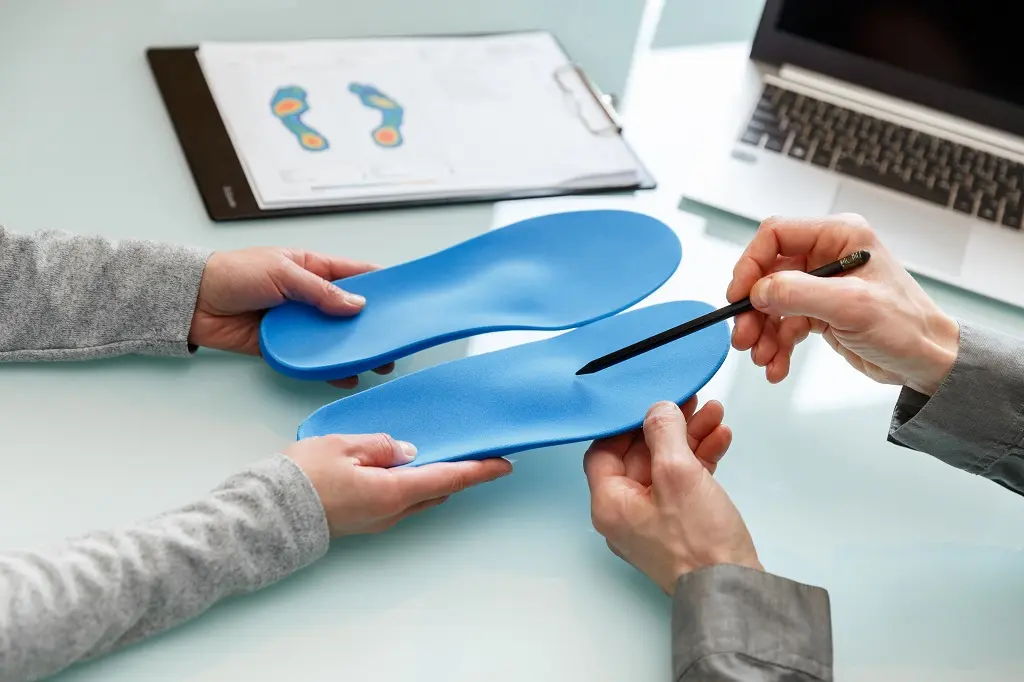
Common Foot Problems Related to Poor Arch Support
Poor arch support can lead to various foot problems, which can significantly affect your hiking and outdoor adventures. Here are some common foot problems associated with inadequate arch support:
- Plantar Fasciitis:
- Description: Plantar fasciitis is one of the most common foot conditions. It occurs when the band of tissue that supports your arch (the plantar fascia) becomes inflamed or strained. It often leads to heel pain and discomfort, especially in the morning or after long hikes.
- Cause: Insufficient arch support can contribute to excessive stress on the plantar fascia, leading to inflammation and pain.
- Shin Splints:
- Description: Shin splints are characterized by pain along the shinbone (tibia) and are common among hikers. Poor arch support can result in improper foot alignment, which may lead to overuse and inflammation of the shin muscles.
- Cause: Inadequate arch support can lead to overpronation, which places additional strain on the shins.
- Achilles Tendonitis:
- Description: Achilles tendonitis is the inflammation of the Achilles tendon, which connects the calf muscles to the heel bone. It can cause pain and discomfort in the back of the ankle and heel.
- Cause: Lack of arch support can contribute to abnormal foot movement, increasing the risk of overstretching and irritating the Achilles tendon.
- Metatarsalgia:
- Description: Metatarsalgia is characterized by pain and inflammation in the ball of the foot, particularly the area beneath the metatarsal bones. It can make walking and hiking uncomfortable.
- Cause: Poor arch support can lead to excessive pressure on the metatarsal area, causing pain and discomfort.
- Flat Feet (Pes Planus):
- Description: Flat feet occur when the arches of the feet collapse, causing the entire sole to make contact with the ground. It can lead to various foot problems, including discomfort and fatigue.
- Cause: Insufficient arch support can exacerbate flat feet by failing to provide the necessary structure and cushioning.
- Blisters and Corns:
- Description: Inadequate arch support can result in uneven weight distribution and friction within your footwear. This can lead to the formation of blisters and corns on the feet, which can be painful and cause discomfort during hikes.
- Back and Knee Pain:
- Description: Poor arch support can affect your overall body alignment, leading to issues like back and knee pain. When your feet are not properly supported, it can impact your gait and posture, causing discomfort in other parts of your body.
- Tired and Fatigued Feet:
- Description: Without proper arch support, your feet can become tired and fatigued much quicker during outdoor activities. This can limit the duration and enjoyment of your hikes or adventures.
- Ankle Instability:
- Description: Inadequate arch support can result in less stable feet, increasing the risk of ankle sprains or twists when navigating uneven terrain.
In summary, poor arch support can lead to a range of foot problems that can hinder your outdoor adventures and cause discomfort. To prevent these issues, it’s essential to invest in quality footwear or arch support insoles that provide the necessary cushioning, stability, and alignment for your feet. Proper arch support can significantly enhance your outdoor experience and reduce the risk of foot-related injuries.
Tips for Maintaining Healthy Arches
Maintaining healthy arches is crucial for overall foot health, especially when engaging in outdoor activities like hiking. Here are some valuable tips to help you keep your arches in top condition:
- Choose the Right Footwear: Select hiking boots or shoes that offer proper arch support. Look for those designed with arch contours and cushioning. Ensure they fit well and provide adequate room for your toes.
- Replace Insoles: If your hiking footwear comes with removable insoles, consider replacing them with high-quality arch support insoles for a customized fit and enhanced support.
- Stretch Regularly: Incorporate stretching exercises into your routine to maintain flexibility in your calf muscles and Achilles tendon. Stretching can help prevent tightness that may impact your arches.
- Strengthen Foot Muscles: Perform exercises that target the muscles of your feet and lower legs. Simple movements like toe curls and heel raises can help strengthen the arch-supporting muscles.
- Maintain a Healthy Weight: Excess weight can put additional strain on your arches. Maintaining a healthy weight through diet and exercise can reduce the risk of arch-related issues.
- Wear Supportive Shoes Off the Trail: Even when not hiking, opt for shoes that provide arch support. Avoid extended periods in footwear that lacks proper support, like flip-flops or unsupportive flats.
- Avoid High Heels: High-heeled shoes can strain your arches. Limit the use of high heels and opt for shoes with a more even heel height to maintain arch health.
- Monitor Your Footwear: Check your hiking boots and shoes regularly for signs of wear and tear, including worn-out insoles or sole wear patterns. Replace them when necessary to ensure continued support.
- Gradual Increase in Activity: When increasing the intensity or duration of outdoor activities, do so gradually. Sudden changes in activity levels can stress your arches and increase the risk of injuries.
- Proper Warm-Up and Cool-Down: Before and after hiking, perform gentle foot and leg stretches to warm up and cool down your muscles. This can help prevent arch strain.
- Hydrate: Proper hydration is essential for overall foot health. Staying well-hydrated can prevent muscle cramps and stiffness that may affect your arches.
- Listen to Your Body: Pay attention to any signs of discomfort or pain in your arches during outdoor activities. If you experience pain, rest, and seek treatment if necessary to prevent further issues.
- Orthotics or Inserts: If you have specific arch-related concerns or foot conditions, consider custom orthotics prescribed by a podiatrist. These can provide tailored support and address individual needs.
- Regular Foot Check-Ups: Schedule periodic check-ups with a podiatrist or foot specialist to assess your arch health and address any emerging issues.
- Maintain Good Overall Foot Hygiene: Keep your feet clean and dry, as moisture can lead to fungal infections. Moisturize your skin to prevent excessive dryness and cracking.
By incorporating these tips into your routine, you can help maintain healthy arches and enjoy your outdoor adventures with greater comfort and reduced risk of arch-related problems.
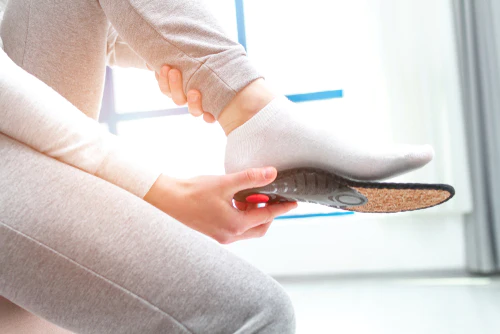
DIY Arch Support Exercises
Here are some do-it-yourself (DIY) arch support exercises that you can incorporate into your routine to strengthen your foot arches and promote overall foot health. These exercises are simple and can be done at home:
- Toe Curls:
- Sit comfortably with your feet flat on the floor.
- Place a small towel or cloth under your feet.
- Use your toes to grip and curl the towel toward you.
- Hold the curl for a few seconds, then release.
- Repeat this exercise for about 10-15 repetitions on each foot.
- Toe Tapping:
- Sit or stand with your feet flat on the floor.
- Lift your toes while keeping your heels on the ground.
- Lower your toes back down.
- Repeat this tapping motion for about 10-15 seconds.
- Gradually increase the duration as your strength improves.
- Arch Raises:
- Stand with your feet hip-width apart.
- Lift your heels off the ground while keeping your toes and the balls of your feet in contact with the floor.
- Hold the raised position for a few seconds.
- Slowly lower your heels back down.
- Perform 10-15 repetitions.
- Marble Pickup:
- Sit in a chair with your feet flat on the floor.
- Place a small bowl of marbles on the ground in front of you.
- Use your toes to pick up one marble at a time and place it in another bowl.
- Continue until you’ve transferred all the marbles.
- This exercise helps improve toe dexterity and arch strength.
- Tennis Ball Massage:
- Sit in a chair and place a tennis ball on the ground.
- Roll your foot over the tennis ball, applying gentle pressure.
- Focus on massaging the arch area as well as the entire sole of your foot.
- Roll the ball back and forth for a few minutes on each foot.
- Calf Stretches:
- Stand facing a wall with your hands against it.
- Step one foot back and keep it straight, with the heel on the ground.
- Bend your front knee while keeping your back leg straight.
- You should feel a stretch in your calf and arch.
- Hold the stretch for 20-30 seconds on each foot.
- Towel Stretch:
- Sit on the floor with your legs extended.
- Loop a towel or resistance band around the ball of one foot.
- Hold the ends of the towel and gently pull it toward you to flex your foot.
- Hold the stretch for 20-30 seconds, feeling the stretch along your arch.
- Switch to the other foot.
Perform these exercises regularly to strengthen the muscles that support your arches and improve their flexibility. As your arches become stronger, you’ll likely experience better overall foot comfort and reduced risk of arch-related issues during your outdoor adventures.
The Connection Between Arch Support and Posture
The connection between arch support and posture is significant and often underestimated. Proper arch support can play a pivotal role in maintaining good overall body posture. Here’s how arch support influences posture:
- Foot Alignment: Arch support helps align the bones and joints of the feet correctly. When your arches are adequately supported, your feet are more likely to rest in a neutral position. This alignment extends up the kinetic chain to affect the positioning of your ankles, knees, hips, and spine.
- Balanced Weight Distribution: Proper arch support ensures that your body weight is evenly distributed across your feet. This prevents excessive pressure on specific areas, such as the balls of your feet or the heels, which can lead to poor posture as you compensate for discomfort.
- Reduced Pronation or Supination: Overpronation (inward rolling of the feet) or supination (outward rolling of the feet) can result in poor alignment of the legs and pelvis, affecting overall posture. Arch support can help correct these issues, promoting a more stable and aligned posture.
- Spinal Alignment: The position of your feet and the alignment of your arches can influence the curvature of your spine. When your feet are well-supported, it encourages a more natural and balanced spinal posture.
- Pelvic Tilt: Arch support can impact the position of your pelvis. When your feet are properly aligned, it helps prevent excessive anterior pelvic tilt (tilting forward) or posterior pelvic tilt (tilting backward), which can affect the curvature of your spine.
- Reduction in Strain: Arch support can alleviate strain on the lower back, which is a common area where poor posture manifests as pain or discomfort. By supporting the arches, you can reduce the stress on the lower back muscles and ligaments.
- Improved Balance: Proper arch support enhances stability and balance, making it easier to maintain an upright posture. This is especially important during activities like hiking, where uneven terrain can challenge balance.
- Enhanced Proprioception: Arch support can improve your awareness of your body’s position and movement in space (proprioception). This heightened awareness helps you make conscious adjustments to maintain better posture.
- Decreased Muscle Fatigue: When your feet are supported, the muscles in your lower legs and feet experience less fatigue. This allows them to provide better support for your posture throughout the day.
- Overall Comfort: Comfort is essential for maintaining good posture. Discomfort in the feet due to inadequate arch support can lead to postural adjustments that may be harmful in the long run.
In summary, proper arch support contributes to better body alignment, balanced weight distribution, and reduced strain on muscles and joints. It can positively impact your posture from the ground up, helping you maintain an upright and comfortable stance during various activities, including outdoor adventures like hiking. Investing in quality footwear with adequate arch support can have a lasting effect on your overall posture and well-being.
Hiking Techniques for Optimal Arch Support
Hiking techniques play a crucial role in ensuring optimal arch support during your outdoor adventures. Proper technique can help prevent discomfort, fatigue, and foot-related issues. Here are some hiking techniques for maintaining the best possible arch support:
- Choose the Right Footwear:
- Start with properly fitting hiking boots or shoes that offer excellent arch support. Ensure they are designed for the specific type of terrain you’ll be hiking on.
- Insert Arch Support Insoles:
- Consider using high-quality arch support insoles or custom orthotics to enhance the arch support provided by your footwear. These can provide a tailored fit and added cushioning.
- Gradual Terrain Adaptation:
- When transitioning to different terrains, allow your feet time to adapt. Gradually increase the difficulty of your hikes to prevent sudden stress on your arches.
- Maintain Proper Lacing:
- Lace your boots or shoes correctly to ensure a secure fit without creating pressure points. Avoid over-tightening, which can affect blood circulation and arch support.
- Mind Your Foot Placement:
- Pay attention to where you place your feet. Aim to land on the middle of your foot, avoiding excessive heel strikes or toe impacts, which can strain your arches.
- Shorten Your Stride:
- Take shorter steps when hiking, especially on uneven terrain. Shortening your stride can help maintain better balance and reduce the risk of overpronation.
- Use Trekking Poles:
- Trekking poles can help distribute some of your body weight and provide stability. They can reduce the load on your arches, particularly during descents.
- Maintain a Natural Gait:
- Walk with a natural, relaxed gait. Avoid walking with your toes pointing inward or outward, as this can strain your arches and lead to discomfort.
- Mind Your Posture:
- Maintain good posture while hiking. Keep your back straight, shoulders relaxed, and your head up. Proper upper body alignment can have a positive impact on your lower body, including your arches.
- Breaks and Stretching:
- Take regular breaks during your hikes to stretch your legs and feet. Perform calf stretches, toe stretches, and arch stretches to relieve tension.
- Hydrate and Rest:
- Stay hydrated to prevent muscle cramps, which can affect your foot posture. Rest when needed to reduce overall fatigue.
- Terrain Assessment:
- Pay attention to the terrain and choose your path wisely. Avoid routes with excessive rocks, roots, or other obstacles that can increase the strain on your arches.
- Monitor Your Feet:
- Periodically check your feet for any signs of discomfort or hot spots. Address any issues promptly to prevent blisters or other foot problems.
- Footwear Maintenance:
- Keep your hiking boots or shoes in good condition. Check for wear and tear, especially in the arch support areas, and replace them when necessary.
- Cool-Down Stretches:
- After completing your hike, perform cool-down stretches to relax your muscles and promote recovery. Focus on stretching the calf muscles and the plantar fascia.
By following these hiking techniques and maintaining proper arch support, you can enjoy your outdoor adventures with reduced discomfort and a lower risk of foot-related issues. Remember that every hiker’s needs are unique, so listen to your body and adjust your techniques as necessary to ensure the best possible arch support for your feet.
Arch Support Accessories
Arch support accessories can be valuable additions to your footwear to enhance comfort and provide additional support for your arches during various activities, including hiking and outdoor adventures. Here are some popular arch support accessories:
- Orthotic Insoles:
- Orthotic insoles are specially designed inserts that can be placed inside your shoes or boots to provide customized arch support. They are available in various shapes and sizes to cater to different arch types and foot conditions.
- Arch Support Inserts:
- Arch support inserts are non-customized insoles with pre-built arch contours. They are readily available and can be easily inserted into your existing footwear to improve arch support.
- Heel Cups and Cushions:
- Heel cups and cushions are inserts that provide additional padding and support to the heel and arch area. They are particularly helpful for individuals with plantar fasciitis or heel pain.
- Arch Sleeves and Supports:
- Arch sleeves or supports are typically made of stretchy fabric and are worn directly on the foot. They provide compression and support to the arch, helping to reduce discomfort and promote proper alignment.
- Arch Straps and Bands:
- Arch straps and bands are worn around the arch of the foot and provide targeted support to alleviate arch pain and discomfort. They are often used during physical activities, including hiking.
- Compression Socks:
- Compression socks apply gentle pressure to the arch and calf muscles, improving blood circulation and reducing swelling. They can be especially beneficial during long hikes to maintain arch support and reduce fatigue.
- Foot Rollers and Massage Balls:
- Foot rollers and massage balls are used to roll under the arch of the foot. This self-massage technique helps relieve tension and promote relaxation in the arch muscles.
- Toe Separators:
- Toe separators can help align and stretch the toes, which indirectly affects the arch and overall foot posture. They can be used as part of a foot care routine to improve arch support.
- Gel Pads and Cushions:
- Gel pads and cushions can be placed under the arch or the entire foot to provide additional cushioning and shock absorption. They are particularly useful for individuals seeking added comfort during hikes.
- Custom Orthotics:
- Custom orthotics are prescribed by podiatrists or orthopedic specialists. These are tailor-made insoles designed to address specific foot conditions and provide maximum arch support.
- Shoe Inserts and Wedges:
- Shoe inserts and wedges can be placed inside your shoes to adjust the angle of your feet and provide better arch support. They are often used to correct issues such as overpronation or supination.
- Arch Support Sandals and Flip-Flops:
- Some brands offer sandals and flip-flops with built-in arch support. These can be a comfortable choice for warm-weather outdoor activities.
When selecting arch support accessories, consider your individual foot type, any existing foot conditions, and the type of activities you’ll be engaging in. It’s essential to choose accessories that provide the appropriate level of support and comfort to enhance your outdoor adventures while maintaining the health of your arches.
Frequently Asked Questions About Arch Support
Let’s address some common queries regarding arch support:
What causes flat arches?
Flat arches can be caused by genetics, obesity, or overuse of unsupportive footwear.
Are custom orthotics necessary for everyone?
Not necessarily. Many people can find suitable arch support through off-the-shelf insoles and footwear.
Can I add arch support to my existing hiking boots?
Yes, you can. Insoles and inserts can be added to most hiking boots to enhance arch support.
How often should I replace my arch support insoles?
It’s recommended to replace them every 6-12 months or when they show signs of wear and tear.
Can proper arch support prevent blisters?
Yes, by reducing friction and evenly distributing pressure, arch support can help prevent blisters during hiking.
Conclusion
Incorporating proper arch support into your hiking and outdoor adventures can greatly enhance your comfort and reduce the risk of foot-related issues. Don’t overlook this essential aspect of your outdoor gear. Invest in quality arch support products and enjoy the beauty of the great outdoors without the distraction of foot discomfort.
